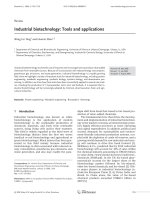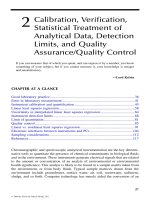Economics principles tools and applications 9th by sullivan sheffrin perez chapter 29
Bạn đang xem bản rút gọn của tài liệu. Xem và tải ngay bản đầy đủ của tài liệu tại đây (631.12 KB, 32 trang )
Economics
NINTH EDITION
Chapter 29
Imperfect Information:
Adverse
Selection and
Moral Hazard
Copyright © 2015, 2012, 2009 Pearson Education, Inc. All Rights Reserved
Learning Objectives
29.1 Explain the notion of adverse selection for buyers.
29.2 Discuss the possible responses to adverse selection for buyers.
29.3 Explain the notion of adverse selection for sellers.
29.4 Explain the notion of moral hazard.
29.5 Use the marginal principle to describe optimal search by consumers.
Copyright © 2015, 2012, 2009 Pearson Education, Inc. All Rights Reserved
29.1 ADVERSE SELECTION FOR BUYERS: THE LEMONS PROBLEM (1 of 9)
Asymmetric information
A situation in which one side of the market—either buyers or sellers—has better information than the other.
Mixed market
A market in which goods of different qualities are sold for the same price.
Copyright © 2015, 2012, 2009 Pearson Education, Inc. All Rights Reserved
29.1 ADVERSE SELECTION FOR BUYERS: THE LEMONS PROBLEM (2 of 9)
Uninformed Buyers and Knowledgeable Sellers
How much is a consumer willing to pay for a used car that could be either a lemon or a plum? To determine a consumer’s willingness to pay in a mixed market
with both lemons and plums, we must answer three questions:
1.
How much is the consumer willing to pay for a plum?
2.
How much is the consumer willing to pay for a lemon?
3.
What is the chance that a used car purchased in the mixed market will be of low quality?
Consumer expectations play a key role in determining the market outcome when there is imperfect information.
Copyright © 2015, 2012, 2009 Pearson Education, Inc. All Rights Reserved
29.1 ADVERSE SELECTION FOR BUYERS: THE LEMONS PROBLEM (3 of 9)
Uninformed Buyers and Knowledgeable
Sellers
If buyers assume that there is a 50–50 chance of a lemon or a plum, they are
willing to pay $3,000 for a used car.
At this price, 20 plums are supplied (point a) along with 80 lemons (point b).
This is not an equilibrium because consumers’ expectations of a 50–50 split
are not realized.
If consumers become pessimistic and assume that all cars on the market will
be lemons, they are willing to pay $2,000 for a used car.
At this price, only lemons will be supplied (point c). Consumer expectations are
realized, so the equilibrium is shown by point c, with an equilibrium price of
$2,000.
Copyright © 2015, 2012, 2009 Pearson Education, Inc. All Rights Reserved
29.1 ADVERSE SELECTION FOR BUYERS: THE LEMONS PROBLEM (4 of 9)
Equilibrium with All Low-Quality Goods
TABLE 29.1 Equilibrium with All Low-Quality Goods
Buyers Initially Have
Equilibrium: Pessimistic
50-50 Expectations
Expectations
Demand Side of Market
Amount buyer is willingness to pay for a lemon
$2,000
$2,000
Amount buyer is willingness to pay for a plum
$4,000
$4,000
Assumed chance of getting a lemon
50%
100%
Assumed chance of getting a plum
50%
0%
Amount buyer is willing to pay for a used car in mixed market
$3,000
$2,000
Number of lemons supplied
80
45
Number of plums supplied
20
0
Total number of used cars supplied
100
45
Actual chance of getting a lemon
80%
100%
Supply Side of Market
Copyright © 2015, 2012, 2009 Pearson Education, Inc. All Rights Reserved
29.1 ADVERSE SELECTION FOR BUYERS: THE LEMONS PROBLEM (5 of 9)
Equilibrium with All Low-Quality Goods
Adverse-selection problem
A situation in which the uninformed side of the market must choose from an undesirable or adverse selection of goods.
The asymmetric information in the market generates a downward spiral of price and quality:
The presence of low-quality goods on the market pulls down the price consumers are willing to pay.
A decrease in price decreases the number of high-quality goods supplied, decreasing the average quality of goods on the market.
The decrease in the average quality of goods on the market pulls down the price consumers are willing to pay again.
Copyright © 2015, 2012, 2009 Pearson Education, Inc. All Rights Reserved
29.1 ADVERSE SELECTION FOR BUYERS: THE LEMONS PROBLEM (6 of 9)
A Thin Market: Equilibrium with Some High-Quality Goods
Thin market
A market in which some high-quality goods are sold but fewer than would be sold in a market with perfect information.
Copyright © 2015, 2012, 2009 Pearson Education, Inc. All Rights Reserved
29.1 ADVERSE SELECTION FOR BUYERS: THE LEMONS PROBLEM (7 of 9)
A Thin Market: Equilibrium with Some High-Quality Goods
If buyers are pessimistic and assume that only lemons will be sold, they are willing
to pay $2,000 for a used car. At this price, 5 plums are supplied (point a), along
with 45 lemons (point b). This is not an equilibrium because 10 percent of
consumers get plums, contrary to their expectations.
If consumers assume that there is a 25 percent chance of getting a plum, they are
willing to pay $2,500 for a used car. At this price, 20 plums are supplied (point c),
along with 60 lemons (point d).
This is an equilibrium because 25 percent of consumers get plums, consistent with
their expectations.
Consumer expectations are realized, so the equilibrium is shown by points c and
d.
Copyright © 2015, 2012, 2009 Pearson Education, Inc. All Rights Reserved
29.1 ADVERSE SELECTION FOR BUYERS: THE LEMONS PROBLEM (8 of 9)
A Thin Market: Equilibrium with Some High-Quality Goods
TABLE 29.2 A Thin Market for High-Quality Goods
Initial Pessimistic
Equilibrium: 75-25
Expectations
Expectations
Amount buyer is willing to pay for a lemon
$2,000
$2,000
Amount buyer is willing to pay for a plum
$4,000
$4,000
Assumed chance of getting a lemon
100%
75%
Assumed chance of getting a plum
0%
25%
$2,000
$2,500
Number of lemons supplied
45
60
Number of plums supplied
5
20
Total number of used cars supplied
50
80
90%
75%
Demand Side of Market
Amount buyer is willing to pay for a used car in mixed market
Supply Side of Market
Actual chance of getting a lemon
Copyright © 2015, 2012, 2009 Pearson Education, Inc. All Rights Reserved
29.1 ADVERSE SELECTION FOR BUYERS: THE LEMONS PROBLEM (9 of 9)
Evidence of the Lemons Problem
The lemons model makes two predictions about markets with asymmetric information.
First, the presence of low-quality goods in a market will at least reduce the number of high-quality goods in the market and may even eliminate them.
Second, buyers and sellers will respond to the lemons problem by investing in information and other means of distinguishing between low-quality and highquality goods.
Copyright © 2015, 2012, 2009 Pearson Education, Inc. All Rights Reserved
APPLICATION 1
ARE BASEBALL PITCHERS LIKE USED CARS?
APPLYING THE CONCEPTS #1: What is adverse selection for buyers?
Professional baseball teams compete with each other for players. After six years of play in the major leagues, a player has the option of becoming a free agent. A player
is likely to switch teams if the new team offers him a higher salary. One of the puzzling features of the free-agent market is that, on average, pitchers who switch
teams spend 28 days per season on the disabled list, compared to only 5 days for pitchers who do not switch teams.
This puzzling feature of the free-agent market for baseball players is explained by asymmetric information and adverse selection.
Suppose the market price for pitchers is $1 million per year, and a pitcher who is currently with the Detroit Tigers is offered this salary by another team.
If the Tigers think the pitcher is likely to spend a lot of time next season recovering from injuries, they won’t try to outbid the other team for the pitcher.
If the Tigers think the pitcher will be injury-free and productive, he will be worth more than $1 million to the them, so they will outbid other teams.
Copyright © 2015, 2012, 2009 Pearson Education, Inc. All Rights Reserved
29.2 RESPONDING TO THE LEMONS PROBLEM (1 of 3)
Buyers Invest in Information
The more information a buyer has, the greater the chance of picking a plum from the cars in the mixed market.
Consumer Reports publishes information on repair histories of different models and computes a “Trouble” index, scoring each model on a scale of 1 to 5. By
consulting these information sources, a buyer improves the chances of getting a high-quality car.
Another information source is Carfax.com, which provides information on individual cars, including their accident histories.
Copyright © 2015, 2012, 2009 Pearson Education, Inc. All Rights Reserved
29.2 RESPONDING TO THE LEMONS PROBLEM (2 of 3)
Consumer Satisfaction Scores from ValueStar and eBay
How can a high-quality service provider distinguish itself from low-quality providers?
ValueStar is a consumer guide and business directory that uses customer satisfaction surveys to determine how well a firm does relative to its competitors in
providing quality service.
Online consumers help each other by rating online sellers.
Copyright © 2015, 2012, 2009 Pearson Education, Inc. All Rights Reserved
29.2 RESPONDING TO THE LEMONS PROBLEM (3 of 3)
Guarantees and Lemons Laws
Sellers can identify a car as a plum in a sea of lemons by offering one of the following guarantees:
Money-back guarantees.
Warranties and repair guarantees.
Copyright © 2015, 2012, 2009 Pearson Education, Inc. All Rights Reserved
APPLICATION 2
REGULATION OF THE CALIFORNIA KIWIFRUIT MARKET
APPLYING THE CONCEPTS #2: How can government solve the adverse-selection problem?
Kiwifruit is subject to imperfect information because buyers cannot determine its sweetness—its quality level—by simple inspection.
There is asymmetric information because producers know the maturity of the fruit, but fruit wholesalers and grocery stores, who buy fruit at the time of harvest, cannot
determine whether a piece of fruit will be sweet or sour.
Before 1987, kiwifruit from California suffered from the “lemons” problem. Maturity levels of the fruit varied across producers. On average, the sugar content at the time
of harvest was below the industry standard.
In 1987, California producers implemented a federal marketing order to address the lemon–kiwi problem. The federal order specified a minimum maturity standard, and
as the average quality of California fruit increased, so did the price. Within a few years, the gap between California and New Zealand prices had decreased
significantly.
Copyright © 2015, 2012, 2009 Pearson Education, Inc. All Rights Reserved
29.3 ADVERSE SELECTION FOR SELLERS: INSURANCE (1 of 6)
A person who buys an insurance policy knows much more about his or her risks and needs for insurance than the insurance company knows. Insurance
companies must pick from an adverse or undesirable selection of customers.
Health Insurance
What is the insurance company’s average cost per customer? To determine the average cost in a mixed market, we must answer three questions:
What is the cost of providing medical care to a high-cost person?
What is the cost of providing medical care to a low-cost person?
What fraction of the customers are low-cost people?
There is asymmetric information in the insurance market because potential buyers know from everyday experience and family histories what type of customer
they are, either low cost or high cost.
Copyright © 2015, 2012, 2009 Pearson Education, Inc. All Rights Reserved
29.3 ADVERSE SELECTION FOR SELLERS: INSURANCE (2 of 6)
Equilibrium with All High-Cost Consumers
If insurance companies assume there will be a 50–50 split between high-cost
and low-cost customers, the average cost of insurance and its price is
$4,000.
At this price, there are 25 low-cost customers (point a) and 75 high-cost
customers (point b). This is not an equilibrium, because 75 percent of
insurance buyers are high-cost customers, contrary to the expectations of a
50–50 split.
If insurance companies become pessimistic and assume that all buyers will
be high-cost consumers, the average cost and price is $6,000.
The insurance company’s expectations are realized, so the equilibrium is
shown by point c.
Copyright © 2015, 2012, 2009 Pearson Education, Inc. All Rights Reserved
29.3 ADVERSE SELECTION FOR SELLERS: INSURANCE (3 of 6)
Equilibrium with All High-Cost Consumers
TABLE 29.3 Equilibrium with All High-Cost Customers
50-50
Equilibrium: Pessimistic
Expectations
Expectations
Cost of serving a high-cost customer
$6,000
$6,000
Cost of serving a low-cost customer
$2,000
$2,000
Assumed fraction of high-cost customers
50%
100%
Assumed chance of low-cost customers
50%
0%
$4,000
$6,000
Number of high-cost customer
75
40
Number of low-cost customers
25
0
Total number of customers
100
40
Actual fraction of high-cost customers
75%
100%
$5,000
$6,000
Supply Side of Market
Expected average cost per customer (price)
Demand Side of Market
Actual average cost per customer
Copyright © 2015, 2012, 2009 Pearson Education, Inc. All Rights Reserved
29.3 ADVERSE SELECTION FOR SELLERS: INSURANCE (4 of 6)
Equilibrium with All High-Cost Consumers
The domination of the insurance market by high-cost people is another example of the adverse-selection problem. The uninformed side of the market (sellers in
this case) must choose from an undesirable or adverse selection of consumers.
The asymmetric information in the market generates an upward spiral of price and average cost of service:
The presence of high-cost consumers in the market pulls up the average cost of service, pulling up the price.
An increase in price decreases the number of low-cost consumers who purchase insurance.
The decrease in the number of low-cost consumers pulls up the average cost of insurance.
In the extreme case, this upward spiral continues until all insurance customers are high-cost people.
Copyright © 2015, 2012, 2009 Pearson Education, Inc. All Rights Reserved
29.3 ADVERSE SELECTION FOR SELLERS: INSURANCE (5 of 6)
Responding to Adverse Selection in Insurance: Group Insurance
Experience rating
A situation in which insurance companies charge different prices for medical insurance to different firms depending on the past medical bills of a firm’s
employees.
Copyright © 2015, 2012, 2009 Pearson Education, Inc. All Rights Reserved
29.3 ADVERSE SELECTION FOR SELLERS: INSURANCE (6 of 6)
The Uninsured
One implication of asymmetric information in the insurance market is that many low-cost consumers who are not eligible for a group plan will not carry
insurance.
Other Types of Insurance
The same logic of adverse selection applies to the markets for other types of insurance. Buyers know more than sellers about their risks, so there is adverse
selection, with high-risk individuals more likely to buy insurance. Because the companies are unable to distinguish between high-risk and low-risk people with
sufficient precision, the adverse-selection problem persists.
Copyright © 2015, 2012, 2009 Pearson Education, Inc. All Rights Reserved
APPLICATION 3 29.4 INSURANCE AND MORAL HAZARD
GENETIC DISCRIMINATION
APPLYING THE CONCEPTS #3: What is adverse selection for sellers?
Genetic discrimination occurs when an insurance company treats a person differently because he or she has a gene mutation that increases the risk of an
inherited disorder.
At the national level the Genetic Information Nondiscrimination Act (GINA) is designed to protect people from genetic discrimination. Title I prohibits genetic
discrimination in health insurance. GINA does not apply to employers with fewer than 15 employees or for life insurance.
The information from genetic testing could help estimate the likely cost of health insurance, which would increase insurance costs for high-cost customers and
lower it for low-cost customers.
The ban on genetic discrimination prevents these sorts of price changes.
Copyright © 2015, 2012, 2009 Pearson Education, Inc. All Rights Reserved
29.4 INSURANCE AND MORAL HAZARD
(1 of 2)
Moral hazard
A situation in which one side of an economic relationship takes undesirable or costly actions that the other side of the relationship cannot
observe.
Insurance Companies and Moral Hazard
Insurance companies use various measures to decrease the moral-hazard problem. Many insurance policies have a deductible—a dollar amount that a policy
holder must pay before getting compensation from the insurance company.
Deductibles reduce the moral-hazard problem because they shift to the policy holder part of the cost of a claim on the policy.
Copyright © 2015, 2012, 2009 Pearson Education, Inc. All Rights Reserved
29.4 INSURANCE AND MORAL HAZARD
(2 of 2)
Deposit Insurance for Savings and Loans
When you deposit money in a Savings and Loan (S&L), the money doesn't just sit in a vault.
The S&L will invest the money, loaning it out and expecting to make a profit when loans are repaid with interest.
Unfortunately, some loans are not repaid, and the S&L could lose money and be unable to return your money.
To protect people, the Federal Deposit Insurance Corporation (FDIC) insures the first $250,000 of your deposit, so if the S&L goes bankrupt, you’ll
still get your money back.
The government enacted the federal deposit insurance law in 1933 in response to the bank failures of the Great Depression.
Copyright © 2015, 2012, 2009 Pearson Education, Inc. All Rights Reserved









